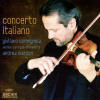Texte paru dans: / Appeared in:

Fanfare Magazine: 33:5 (05-06/2013)
Pour
s'abonner / Subscription information
Les abonnés à Fanfare Magazine ont accès aux archives du
magazine sur internet.
Subscribers to Fanfare Magazine have access to the archives of the magazine
on the net.
Archiv 4776606

Code-barres / Barcode:
0028947766063 (ID9)
Consultez toutes les évaluations recensées pour ce cd
~~~~ Reach all the evaluations located for this CD
Even to violin aficionados, Domenico dall’Oglio and Michele Stratico should be newcomers, though they will most likely have heard of Pietro Nardini (most likely through his familiar Sonata in D Major and “Concerto” in E Minor, a work pieced together and orchestrated from sonata movements), while Antonio Lolli has a place in histories of the violin as Paganini’s precursor (though perhaps with a tarnished reputation as somewhat of a charlatan). The program of their concertos assembled by Olivier Fourès, therefore, provides an opportunity to make an acquaintance with some attractive composers and repertoire and a reacquaintance with others.
Michael Horst’s notes describe dall’Oglio as a follower (and possible student) of Vivaldi, and the opening of his Concerto in C Major, with its pounding rhythmic motive complemented by lightening runs, may remind listeners, at least for a few paragraphs, of Vivaldi’s Concerto in D Major, RV 234, “L’Inquietudine,” though the mood of dall’Oglio’s concerto isn’t nearly so agitated. Vivaldi’s frame has been stretched to accommodate almost 20 minutes of music, equally divided among the three movements, with the cantabile slow movement accompanied in this performance by the kind of kaleidoscopic timbres that Marcon and the orchestra brought to Vivaldi’s slow movements. Carmignola’s temperament seems well suited to the cocky last movement’s combination of lyricism and sparkling figuration. Especially in the slow movement, the engineers have captured Carmignola closely and clearly enough to pick up heavy breathing, which, as I’ve noted on other occasions, listeners in a concert hall would be spared (and which I’ve seldom heard close up) but has now become acceptable in recordings.
The added weight of Michele Stratico’s Concerto in G Minor comes as much from its association with Tartini’s style as from the darker key. Horst suggests that the Paduan Stratico composed as many as 61 violin concertos, if not so luxuriant a heritage as Vivaldi’s—or, for that matter, Tartini’s—hundreds, still a significant number by the standards even of the early 19th century. This one, nearly 20 minutes long, centers on its slow movement, by several minutes the longest. Tartini himself emphasized vocal lyricism in his compositions for the violin, going so far as to accuse Vivaldi of writing for the voice in such a way as to take the throat as a violin’s neck. Still, Tartini’s concertos usually contain their share of passagework; Stratico’s concerto, on the other hand, sounds tamer, though thickly textured and attractively melodic, the latter a quality of which Carmignola takes full advantage. (The slow movement, once again, features an accompaniment of heavy breathing.)
Violin students used to encounter Nardini’s “Concerto” in E Minor; Mischa Elman recorded the concoction (as did Peter Rybar)—and Florian ZaBach used to play it, dashingly, of course, in pops concerts. Perhaps it takes a personality like ZaBach’s to put it across, but Nardini’s real Concerto in G Minor seems cut technically from an entirely different bolt of cloth, though displaying enough cognate harmonic and melodic patterns to identify it as the same composer’s work. Carmignola brings the kind of arch brilliance to the first and third movements as he reveals in works by Vivaldi, though this one differs in its subterranean lyrical vein (Nardini, a student of Tartini, who seems to have strongly influenced him, thought enough of his teacher to nurse him in his last illness). The slow movement, the briefest of the three, presents the soloist in a plaintive mood before a cadenza introduces the movement’s concluding tutti.
Lolli’s Violin Concerto in C Major, op. 2/2, the program’s longest work, lasting nearly 25 minutes, may already be familiar to listeners, most recently from a recording of Lolli’s complete op. 2 by Luca Fanfoni and Reale Concerto, Dynamic 527/1-3 (Fanfare 32:3). Carmignola flicks off the grace notes that spice the first and third movements’ themes with dapper insouciance. But, despite its dominant solo part, this concerto hardly seems to subordinate musical ideas to technical display, though seldom rising to Paganini’s or even Locatelli’s level of brilliance—a general impression listeners might well receive as well from the works in Fanfoni’s complete set, though Carmignola attests in the notes to the concerto’s extremely high level of difficulty. If that’s so, then Carmignola, as well as Lolli, show themselves capable of producing art that conceals art. Carmignola preserves his purity of tone high in the upper registers in the last movement. He plays, according to the notes, the 1732 Baillot Stradivari, loaned by the Fondazione Cassa di Risparmio (can this be the Baroque-fitted instrument depicted in the booklet and on the jewel case’s inside back?). In any case, the Venice Baroque Orchestra’s performance of the concerto surpasses in elegance, however brusque, and subtlety, however dependent on timbral devices, Fanfoni’s performance, though those averse to period instruments may find its detail too fussy for their tastes.
Marcon and the orchestra adapt to the related yet different styles of the composers, calibrating to each their approach to dynamics and articulation. The notes suggest that Carmignola initially had reservations about the program because he takes little interest in “archaeological” projects. That he embraced it thereafter suggests how strong an impression the program can make. Strongly recommended, accordingly—to violinists, historians, and generally.
Cliquez l'un ou l'autre
bouton pour découvrir bien d'autres critiques de CD
Click either button for many other reviews


